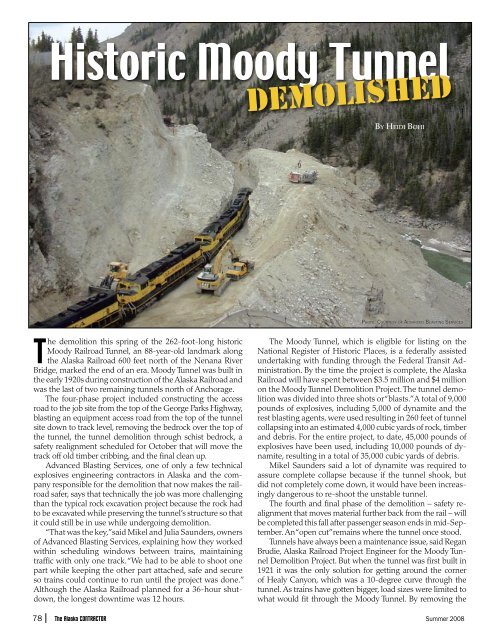The Alaska Contractor - Summer 2008
The Alaska Contractor - Summer 2008
The Alaska Contractor - Summer 2008
Create successful ePaper yourself
Turn your PDF publications into a flip-book with our unique Google optimized e-Paper software.
Historic Moody Tunnel<br />
he demolition this spring of the 262-foot-long historic<br />
Moody Railroad Tunnel, an 88-year-old landmark along<br />
the <strong>Alaska</strong> Railroad 600 feet north of the Nenana River<br />
Bridge, marked the end of an era. Moody Tunnel was built in<br />
the early 1920s during construction of the <strong>Alaska</strong> Railroad and<br />
was the last of two remaining tunnels north of Anchorage.<br />
<strong>The</strong> four-phase project included constructing the access<br />
road to the job site from the top of the George Parks Highway,<br />
blasting an equipment access road from the top of the tunnel<br />
site down to track level, removing the bedrock over the top of<br />
the tunnel, the tunnel demolition through schist bedrock, a<br />
safety realignment scheduled for October that will move the<br />
track off old timber cribbing, and the final clean up.<br />
Advanced Blasting Services, one of only a few technical<br />
explosives engineering contractors in <strong>Alaska</strong> and the company<br />
responsible for the demolition that now makes the railroad<br />
safer, says that technically the job was more challenging<br />
than the typical rock excavation project because the rock had<br />
to be excavated while preserving the tunnel’s structure so that<br />
it could still be in use while undergoing demolition.<br />
“That was the key,” said Mikel and Julia Saunders, owners<br />
of Advanced Blasting Services, explaining how they worked<br />
within scheduling windows between trains, maintaining<br />
traffic with only one track. “We had to be able to shoot one<br />
part while keeping the other part attached, safe and secure<br />
so trains could continue to run until the project was done.”<br />
Although the <strong>Alaska</strong> Railroad planned for a 36-hour shutdown,<br />
the longest downtime was 12 hours.<br />
demolished<br />
BY HEIDI BOHI<br />
<br />
<br />
<strong>The</strong> Moody Tunnel, which is eligible for listing on the<br />
National Register of Historic Places, is a federally assisted<br />
undertaking with funding through the Federal Transit Administration.<br />
By the time the project is complete, the <strong>Alaska</strong><br />
Railroad will have spent between $3.5 million and $4 million<br />
on the Moody Tunnel Demolition Project. <strong>The</strong> tunnel demolition<br />
was divided into three shots or “blasts.” A total of 9,000<br />
pounds of explosives, including 5,000 of dynamite and the<br />
rest blasting agents, were used resulting in 260 feet of tunnel<br />
collapsing into an estimated 4,000 cubic yards of rock, timber<br />
and debris. For the entire project, to date, 45,000 pounds of<br />
explosives have been used, including 10,000 pounds of dynamite,<br />
resulting in a total of 35,000 cubic yards of debris.<br />
Mikel Saunders said a lot of dynamite was required to<br />
assure complete collapse because if the tunnel shook, but<br />
did not completely come down, it would have been increasingly<br />
dangerous to re-shoot the unstable tunnel.<br />
<strong>The</strong> fourth and final phase of the demolition – safety realignment<br />
that moves material further back from the rail – will<br />
be completed this fall after passenger season ends in mid-September.<br />
An “open cut” remains where the tunnel once stood.<br />
Tunnels have always been a maintenance issue, said Regan<br />
Brudie, <strong>Alaska</strong> Railroad Project Engineer for the Moody Tunnel<br />
Demolition Project. But when the tunnel was first built in<br />
1921 it was the only solution for getting around the corner<br />
of Healy Canyon, which was a 10-degree curve through the<br />
tunnel. As trains have gotten bigger, load sizes were limited to<br />
what would fit through the Moody Tunnel. By removing the
















